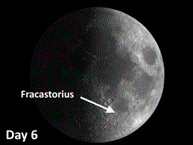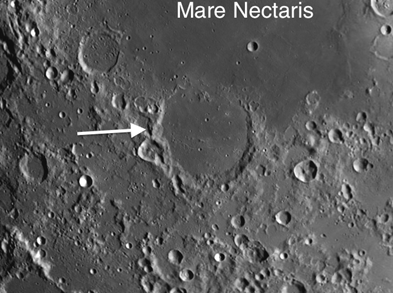 The week of March 20-26 takes us from Day 29 to Day 6 This week we will highlight the moon crater Fracastorius, located in the SE quadrant of the Field Map and viewable on Sunday night.
The week of March 20-26 takes us from Day 29 to Day 6 This week we will highlight the moon crater Fracastorius, located in the SE quadrant of the Field Map and viewable on Sunday night.
 Fracastorius: [SE/M13; L=33°E] Located on the south shore of Mare Nectaris, this is one of the Moon’s best examples of subsidence. The Nectaris lavas were so heavy that the floor of Fracastorius actually cracked as it bent downward and allowed the Nectaris lavas to flow over its northern rim. If you’re lucky and have good optics and good seeing, you might actually glimpse the unnamed rille that crosses the floor from east to west just south of the center. There is a tiny 2.5-mi. crater right in the middle of this rille that may help you spot it. (Daguerre on the north shore [L13] and its adjoining unnamed neighbor have both fallen victim to the same process of subsidence.)
Fracastorius: [SE/M13; L=33°E] Located on the south shore of Mare Nectaris, this is one of the Moon’s best examples of subsidence. The Nectaris lavas were so heavy that the floor of Fracastorius actually cracked as it bent downward and allowed the Nectaris lavas to flow over its northern rim. If you’re lucky and have good optics and good seeing, you might actually glimpse the unnamed rille that crosses the floor from east to west just south of the center. There is a tiny 2.5-mi. crater right in the middle of this rille that may help you spot it. (Daguerre on the north shore [L13] and its adjoining unnamed neighbor have both fallen victim to the same process of subsidence.)
There are some quite small objects on the floor of Fracastorius requiring high quality optics and steady seeing. How many of these can you detect? Make a quick sketch, then come back later to compare.
OF ADDITIONAL INTEREST IN SPACE
New Moon is on Tuesday. On Wednesday, Jupiter is 0.5° north of the Moon, and on Friday Venus is only 0.1° north of the Moon.
======================
It is highly recommended that you get a copy of Sky and Telescope’s Field Map of the Moon, the very finest Moon map available for use at the telescope. It is available for $10.95 at www.skyandtelescope.com and on Amazon. All features mentioned in this blog will be keyed to the grid on the Field Map and will look like this: Plato: [NW/D9]
Credits:
Courtesy of Gray Photography of Corpus Christi, Texas
Lunar photos: NASA / USGS / BMDO / LROC / ASU / DLR / LOLA / Moon Globe. Used by permission
- Rupes Cauchy: A Best Known Fault on the Moon - July 22, 2024
- Moon Crater Schickard – Crater Floor has Stripes - July 15, 2024
- Moon Craters Langrenus and Vandelinus - July 8, 2024